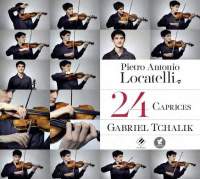Texte paru dans: / Appeared in:

Fanfare Magazine: 38:2 (11-12/2014)
Pour
s'abonner / Subscription information
Les abonnés à Fanfare Magazine ont accès aux archives du
magazine sur internet.
Subscribers to Fanfare Magazine have access to the archives of the magazine
on the net.
Evidence
EVCD002

Code-barres / Barcode : 3149028057720
Gabriel Tchalik plays all of Pietro Locatelli’s 24 Caprices, each intended to grace a fast movement from the composer’s violin concertos, op. 3, L’arte del violino, in an integral performance. Who knows just what Locatelli would have thought of such a project? It’s easier to figure out what listeners to Tchalik’s recital will—or ought to—think. He brings to these early caprices a virtuosic flair light years beyond the elegant and sonorous performances Roberto Michelucci gave some of them in his early recording with I Musici. The intervening years, and the coming of the historical performance proponents, have changed everything and, using a modern violin, Tchalik creates the excitement that ensembles like Il Giardino Armonico once brought to familiar Baroque literature. If the tessitura of the caprices seems high, they’re just a continuation of the stratospheric flights Locatelli took in the concerto movements themselves. In fact, passages that seem extraordinarily high in themselves come with the direction to be played an octave higher. Not everything in the caprices lies so high, of course, but enough does to make them striking even in post-post-post Paganini times. In fact, it’s said that Paganini himself studied them and paid tribute to their recurring arpeggiation his own Caprices, op. 1. But in fact, the darkness of some of them (like No. 4 in C Minor) also prefigures a sort of sultriness in some of Paganini’s Caprices (and No. 14 seems as diabolical in spots as the more chromatic No. 16 of Paganini’s Caprices). Tchalik follows the Schott edition from 2002, and he adds slight cadenzas at the end, which Albert Dunning indicates in this well-annotated and eminently practical edition. These realizations of what look like shorthand in spots depend upon choices, but it’s hard to criticize any of these decisions in terms of sheer effectiveness.
That Tchalik employs a powerful yet sweet-sounding modern violin (very modern, made by Philippe Mitéran in 2007) and has been recorded up close by the engineers gives these solo works a sort of larger-than-life quality in this setting that might be hard to duplicate in the concert hall. But he’s also larger than life in another way: His sense of fantasy and his general brilliance combine to make these works almost as entertaining on the purely instrumental level as Paganini’s Caprices, with an almost equal diversity despite the ubiquitous arpeggios and chords that make them up. So those who have heard Locatelli’s Caprices only in their natural habitat may find this way of listening to them a bit startling—new and fresh—and should find in them an entire self-contained musical universe parallel to the technical one. Even Ruggiero Ricci, who played the “Harmonic Labyrinth” (No. 23) as a virtuoso showpiece (as did Henryk Szeryng and David Oistrakh) might have struggled to make the entire set as convincing musically as does Tchalik. Single-handedly, he could have acquitted Locatelli of any charge of empty virtuosity with this recording of his caprices only. That’s saying a lot. But there’s a lot to say about this recording, which virtually demands to be enthusiastically recommended to every kind of listener.
Cliquez l'un ou l'autre
bouton pour découvrir bien d'autres critiques de CD
Click either button for many other reviews


